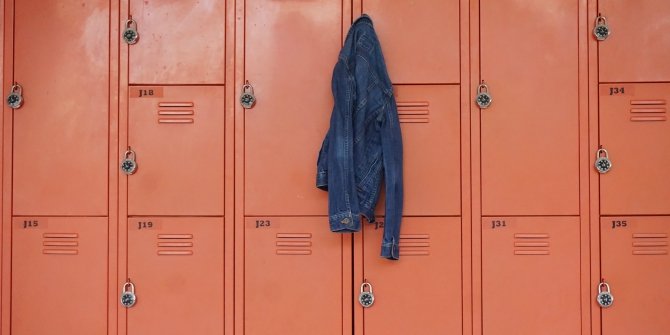In lots of US college districts, there are sometimes vital variations in scholar suspension charges between African American and Hispanic or Latinx college students and White college students. Utilizing knowledge on in-school suspensions from greater than 6,500 college districts in over 100 US metropolitan areas Jin Lee finds that demographically even college districts report bigger variations in in-school suspension charges. She writes that publicity to variety with solely restricted interplay between teams does little to decrease current ethnic and racial prejudice and stereotypes from White majority communities which usually tend to exploit social management and punitive punishment towards African American and Hispanic or Latinx college students. Extra segregated college districts the place there’s larger interplay, in contrast, usually tend to report smaller variations in in-school suspension charges.
Eradicating kids who don’t conform to anticipated behavioral requirements from a classroom has turn out to be a typical technique for bettering educational instruction for the remaining college students. In mild of latest gun deaths, American colleges have more and more criminalized nonviolent actions and minor misconduct by college students. Nonetheless, disciplinary actions have a larger that means than a easy administrative process. Exclusionary insurance policies corresponding to in-school suspension, out-of-school suspension, and expulsion have been criticized for contributing to a lack of studying ensuing from missed time in class and college students withdrawing from schooling. Within the US, which has struggled with ongoing segregation and an rising disparity amongst racial and ethnic teams, these dangerous results of college self-discipline have been evident within the experiences of scholars of a specific race, ethnicity, gender, or earnings degree.
What shapes differing suspension charges?
Though college students of shade are extra steadily suspended and expelled than their White friends within the US, there’s a persevering with debate about whether or not race and ethnicity are a predictor of disruptive behaviors. Any prejudice held by an individual who refers and suspends kids can heighten the racial imbalance in scholar suspensions. Moreover, college students in high-poverty communities could obtain extra disciplinary actions as a result of their college districts closely depend on disciplinary insurance policies to simply management kids’s misconduct. This implies that gaps in suspension charges are affected by exterior components past private traits. In different phrases, a excessive proportion of minority college students in suspension may be formed by the challenges which can be confronted in a toddler’s on a regular basis life.
The present consciousness of the disproportionate charges of scholar suspensions for African American, Hispanic or Latinx college students calls into query whether or not a faculty neighborhood constructed with understanding and responsiveness towards minority teams may alleviate the hole in suspensions between White and African American, Hispanic or Latinx college students. As a result of the dynamics of race and ethnicity relations in a neighborhood could affect perceptions and attitudes towards scholar misbehaviors, in latest analysis I discover the likelihood that racial gaps in scholar suspension charges can shut or widen in demographically various communities. By analyzing in-school suspensions in additional than 6,500 college districts in 102 US metropolitan areas, my analysis argues that demographically even college districts report bigger variations in in-school suspension charges between African American and White college students and between Hispanic or Latinx college students and White college students.
Does extra various, imply kind of tolerant?
Simply as built-in academic environments can slim achievement gaps amongst various scholar populations, exposing college students to various environments of their on a regular basis lives may be instrumental in decreasing racial gaps in class self-discipline. The intergroup contact speculation, first proposed by psychologist Gordon Allport in 1954, argues that restricted interplay between various teams in segregated communities reinforces discrimination and stereotyping. In response to this speculation, desegregated colleges and faculty districts scale back racial and ethnic disparities in scholar suspension by eliminating racial stigma and the biased judgment of scholar behaviors. Nonetheless, a easy improve in several teams’ publicity to one another – particularly within the US, the place ethnic and racial prejudice and stereotypes are a deeply rooted challenge – can result in the bulk perceiving the minority as political or financial rivals. Contemplating that White majority communities usually tend to exploit social management and punitive punishment towards sure teams – the racial menace speculation – opposite to the intergroup contact speculation, affords a really completely different perspective on demographic variety.
Determine 1 beneath exhibits that more-segregated college districts with greater dissimilarity index values (the dissimilarity index measures the proportion of a given racial group that would wish to maneuver into othercensus block teams to make sure full integration) report smaller variations in in-school suspension charges between African American and White college students and between Hispanic or Latinx college students and White college students. The uneven distribution of African American enrollments throughout college districts narrows racial gaps within the in-school suspension charges. Nonetheless, frequent publicity between Black and White populations inside zip-code areas moderates the racial disproportion in scholar disciplinary practices. Moreover, elevated publicity to a distinct race inside a zip-code space weakens racial gaps in in-school suspension. This optimistic impact of integration on the in-school suspension hole between White and Black college students is reported solely in zip-code areas, not in class districts. The good thing about interracial interplay in a shared house disappears for Hispanic college students in class districts.
Determine 1- Confidence intervals for regression coefficients of segregation indices
A name for deliberate inclusiveness
Curiosity in the place suspended and expelled college students reside just isn’t new, and this curiosity has grown with the just lately rising implementation of punitive scholar sanctions, even on the kindergarten degree, resulting in rising racial gaps in class disciplinary practices. My research challenges the overall perception that demographically built-in college districts and communities see smaller racial and ethnic gaps in class self-discipline. Opposite to the expectation that demographically various college districts witness smaller gaps in in-school suspension charges by race and ethnicity as a result of a greater understanding of intergroup relations, college students of shade in these districts usually tend to be uncovered to hostile and unsupportive environments for a frequent use of punitive controls. My analysis emphasizes structural points reasonably than particular person traits by replicating conventional racial classifications within the subject of criminology and legal justice.
Though my research partly helps the potential of racial menace in exclusionary college self-discipline practices focused towards minority college students, it additionally highlights that improved integration caused by frequent interplay between completely different races inside college districts and neighborhoods could alleviate racial and ethnic gaps in in-school suspension charges. Present approaches to measuring segregation and integration in a plain ratio between subgroups don’t sufficiently account for an inverse and unintended impact of variety on interracial tensions in public house. In various college settings, misperceptions about completely different races and ethnicities can result in a biased administration of disciplinary college insurance policies, together with a rising prevalence of surveillance programs and an growth of zero-tolerance insurance policies. This requires the event of not simply various but additionally intentionally inclusive college and neighborhood environments.


